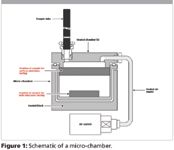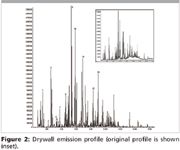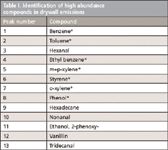Analyzing Construction Product Emissions Using Novel Micro-Chamber Technology with Thermal Desorption–GC–MS
The release of certain chemicals from building products is of increasing concern due to their potential detrimental effect on human health and the environment; therefore, new regulations requiring the production of low emission materials are currently being implemented.
Caroline Widdowson, Markes International, Ltd.
The release of certain chemicals from building products is of increasing concern due to their potential detrimental effect on human health and the environment; therefore, new regulations requiring the production of low emission materials are currently being implemented. Novel sampling technology has been developed to help building product manufacturers obtain informative emissions data in order to develop compliant products and maintain product quality on a routine basis.
Many construction products (e.g. paints, sealants, drywall, flooring, and wood paneling) are responsible for the release of harmful chemicals, specifically volatile organic compounds (VOCs) and formaldehyde, to indoor air and the environment. Some Chinese drywall products, for example, have been found to emit high levels of VOCs, semi-VOCS (SVOCs), and sulfur compounds, which can adversely affect the health of building occupants (1). In response to growing concerns, regulations are being implemented (e.g. the International Green Construction Code [IgCC]), which require the production of low emission, "green" building materials (2). Similarly, California Specification 01350 is a product approval standard, which names a variety of VOCs that need to be monitored due to their potential toxicity in consumers (3).
In order to develop compliant products and routinely monitor product quality, most manufacturers will want the ability to screen product emissions in-house. Emissions testing for product approval is carried out by accredited laboratories and involves incubating materials in an enclosed chamber at (near-) ambient temperature under a flow of clean humidified gas for several days. Emitted vapors are then collected onto a sorbent tube followed by thermal desorption (TD)–GC–MS for VOC analysis, or onto a DNPH cartridge with HLPC for formaldehyde analysis (4). TD is an automated sample extraction/concentration technique used to increase the sensitivity of VOC analysis by GC–MS. To simplify and speed up in-house emissions screening for manufacturers, novel micro-chamber technology has been developed. Such equipment is compact, robust, and able to process several samples each hour. The emissions data obtained have been shown to correlate with longer term reference tests and can be used to maintain factory production (quality) control and to enhance new product development (5–8). Data can also be useful for prescreening samples going for third party tests and for evaluating emission profile variations across a product range. Figure 1 shows a schematic of a micro-chamber for material emissions sampling.

Figure 1
A sample of drywall (plasterboard) was obtained for emissions screening using the micro-chamber–TD–GC–MS system, to test the system's suitability for analysis of a complex sample.
Experimental Conditions
A representative amount of drywall (44 mm diameter circle) was placed into one of the chambers of the Micro-Chamber/Thermal Extractor™ (Markes International Ltd., UK). The chamber was set to 50 °C and a flow of gas (100 ml/min) was applied. A slightly higher than ambient temperature was used to compensate for the relatively small sample size and speed up equilibration (30 min), while not significantly affecting the emission profile. The vapor exhausted was collected for 12 min onto a 3.5" × 6.4 mm OD stainless steel tube (Markes International) packed with quartz wool, Tenax® TA (Buchem BV, The Netherlands) and Carbograph 5 TD (Lara Laboratori, Italy).
The tube was then thermally desorbed on a UNITY 2™ TD system (Markes International) with subsequent GC–MS analysis (Agilent 6890/5975) under the following conditions:
Tube desorption: 5 min, 300 °C
TD split: 25:1
Focusing trap: Materials emissions trap (Markes International) U-T12ME-2S
Trap low temp: 0 °C
Trap high temp: 300 °C
Column: 30 m × 0.25 mm × 0.5 μm DB-5 phase
Results
The chromatogram obtained was processed using ClearView™ software (ALMSCO International Ltd., UK). This removes background interference in order to improve peak integration and compound identification. The original data file is retained (e.g. for total VOC calculations).
The conditions used during vapor sampling were chosen to provide an emissions profile representative of the drywall under normal use. The sorbents and temperatures used for TD were selected to retain the widest possible range of analytes emitted. This method resulted in a complex total ion chromatogram (TIC), comprising a very high number of VOCs and SVOCs, and a wide range of analyte concentrations — illustrating the versatility and efficiency of the combined analytical system (Figure 2).

Figure 2
Table I lists some of the most significant compounds in the TIC including volatile and semi-volatile components. In addition, with the new building product regulations in mind, several compounds of particular interest were found in the drywall emission profile. A number of VOCs specified by California 01350 were detected in the TIC; these are highlighted with an asterisk in Table I. Relatively high levels of benzene, a known carcinogen, and phenol, which affects the central nervous system and kidneys, were detected.

Table I. Identification of high abundance compounds in drywall emissions
Conclusions
Recent innovations in micro-chamber technology allow manufacturers to screen emissions for their products in-house. The generation of a comprehensive chemical profile, as shown here, has resulted in the detection of a wide range of VOCs and SVOCs emitted by the sample. In addition, several compounds targeted under key construction product test protocols were identified. This demonstrates that the micro-chamber–TD–GC–MS methodology can be used to obtain useful emissions data from chemically complex building products. Such data will enable a company to routinely test their products in order to comply with regulations and to develop new low emission materials, thus protecting their business, the consumer, and the environment.
References
(1) L.E. Saltzmann, US Consumer Product Safety Commission staff summary of contractor's indoor air quality assessment of homes containing Chinese drywall (2009).
(2) International Green Construction Code™ Public Version 1.0 (2010).
(3) California 01350 (2004) Standard practice for the testing of volatile organic emissions from various sources using small-scale environmental chambers http://www.cal-iaq.org/VOC/Section01350_7_15_2004_FINAL_PLUS_ADDENDUM-2004-01.pdf.
(4) Markes International TDTS Note 89: Thermal desorption technology for testing chemical emissions from construction products and consumer goods.
(5) T. Schripp, B. Nachtwey, J. Toelke, T. Salthammer, E. Uhde, M. Wensing, M. Bahadir. A micro-scale device for testing emissions from materials for indoor use. Analytical and Bioanalytical Chemistry, 387 (5), 1907–1919 (2007).
(6) PARD report: G.J. Williams, M. Pharaoh. Correlation between the VDA 276 test and micro-chamber testing. Issued by WMG, University of Warwick, UK (2009).
(7) Markes International TDTS Note 67: Introducing the Micro-Chamber/Thermal Extractor™ (μ-CTE™) for rapid screening of chemicals released (emitted) by products and materials.
(8) Markes International TDTS Note 68: Using Markes emission screening technology to simplify compliance with the latest construction product regulations.

Markes International, Ltd.
Gwaun Elai Medi Science Campus, Llantrisant CF72 8XL UK
tel. +44 (0)1443 230935; fax +44 (0)1443 231531
Website: www.markes.com

SEC-MALS of Antibody Therapeutics—A Robust Method for In-Depth Sample Characterization
June 1st 2022Monoclonal antibodies (mAbs) are effective therapeutics for cancers, auto-immune diseases, viral infections, and other diseases. Recent developments in antibody therapeutics aim to add more specific binding regions (bi- and multi-specificity) to increase their effectiveness and/or to downsize the molecule to the specific binding regions (for example, scFv or Fab fragment) to achieve better penetration of the tissue. As the molecule gets more complex, the possible high and low molecular weight (H/LMW) impurities become more complex, too. In order to accurately analyze the various species, more advanced detection than ultraviolet (UV) is required to characterize a mAb sample.














